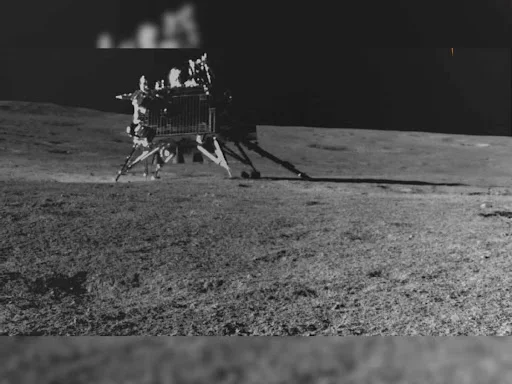NASA Orbiter Snaps Brilliant ‘Bird’s Eye View’ of Chandrayaan-3’s Vikram Lander Near Moon’s South Pole
India's Chandrayaan-3 mission has achieved a remarkable feat by successfully landing a lander and a rover near the lunar south pole, a region that has never been explored before by any country. The mission, which was launched on July 14, 2023, from the Satish Dhawan Space Centre in Sriharikota, India, consists of a propulsion module, a lander named Vikram, and a rover named Pragyan. The propulsion module carried the lander and the rover from the Earth to the Moon and inserted them into a lunar orbit on August 5. The lander then separated from the propulsion module and performed a soft landing on the lunar surface on August 23 at 12:33 UTC, making India the fourth country to successfully land on the Moon, and the first to do so near the region of the lunar south pole.
The landing site of Vikram is located about 600 km from the Moon's south pole, between two craters named Manzinus C and Simpelius N. The lander deployed the rover Pragyan, which rolled out of its belly and began exploring the lunar terrain. The lander and the rover have been conducting various scientific experiments and sending back data and images to the Indian Space Research Organisation (ISRO), which is managing the mission. The lander and the rover have a mission life of one lunar day, which is equivalent to about 14 Earth days. They are currently in sleep mode due to the onset of lunar night, which lasts for about 14 Earth days. They are expected to wake up again around September 22, when the next lunar day begins.
One of the most stunning images of the Chandrayaan-3 mission was captured by NASA's Lunar Reconnaissance Orbiter (LRO), which has been orbiting the Moon since 2009. The LRO has a camera called LROC (Lunar Reconnaissance Orbiter Camera), which can take high-resolution images of the lunar surface. On August 27, four days after the Chandrayaan-3 landing, the LROC acquired an oblique view of the Vikram lander from a slew angle of 42 degrees. The image shows the lander as a tiny speck in the center, with its dark shadow visible against the bright halo surrounding it. The halo is caused by the rocket plume interacting with the fine-grained regolith (soil) during the landing. The image also shows some features of the landing site, such as craters, hills, and boulders.
The LROC image is a remarkable achievement for both NASA and ISRO, as it provides a bird's eye view of the Chandrayaan-3 lander on the Moon. It also demonstrates the cooperation and collaboration between the two space agencies, which have been working together on various lunar missions. For instance, NASA's LRO had also located the debris of Chandrayaan-2's Vikram lander in 2019, after it crash-landed on the Moon⁵. Moreover, NASA has provided some scientific instruments for Chandrayaan-3, such as a laser retroreflector array (LRA) on board the Vikram lander and a spectro-polarimeter (SHAPE) on board the propulsion module.
The Chandrayaan-3 mission is a milestone for India's space exploration program, as it showcases its technological capabilities and scientific ambitions. The mission also contributes to humanity's understanding of the Moon, especially its south polar region, which holds great potential for future exploration and utilization. The south pole of the Moon is of particular interest because it has permanently shadowed regions that may contain water ice and other volatiles, which could be useful for sustaining human presence or generating fuel. The south pole also offers a unique vantage point for observing the Earth and other celestial bodies.
The Chandrayaan-3 mission is not only a proud moment for India, but also for all space enthusiasts around the world. It is an inspiring example of how space exploration can bring out the best in humanity, by fostering curiosity, creativity, and collaboration.
Source:
(1) Chandrayaan-3 - Wikipedia. https://en.wikipedia.org/wiki/Chandrayaan-3.
(2) Chandrayaan-3 - Indian Space Research Organisation (ISRO). https://www.isro.gov.in/ISRO_EN/Chandrayaan3_New.html.
(3) Chandrayaan-3: A complete guide to India's third mission to the moon. https://www.space.com/chandrayaan-3-indian-moon-mission-rover.
(4) Chandrayaan-3 mission: NASA's Lunar Reconnaissance Orbiter reveals Vikram landing site details. https://timesofindia.indiatimes.com/chandrayaan-3-mission-nasas-lunar-reconnaissance-orbiter-reveals-vikram-landing-site-details/videoshow/103442253.cms.
(5) How 'jugaad' made Europe's Solar Orbiter see Sun like never before. https://www.msn.com/en-in/news/techandscience/how-jugaad-made-europes-solar-orbiter-see-sun-like-never-before/ar-AA1gnCBe.
(6) Vikram landed 600 km from south pole: NASA. https://www.thehansindia.com/news/cities/bengaluru/vikram-landed-600-km-from-south-pole-nasa-820859.








